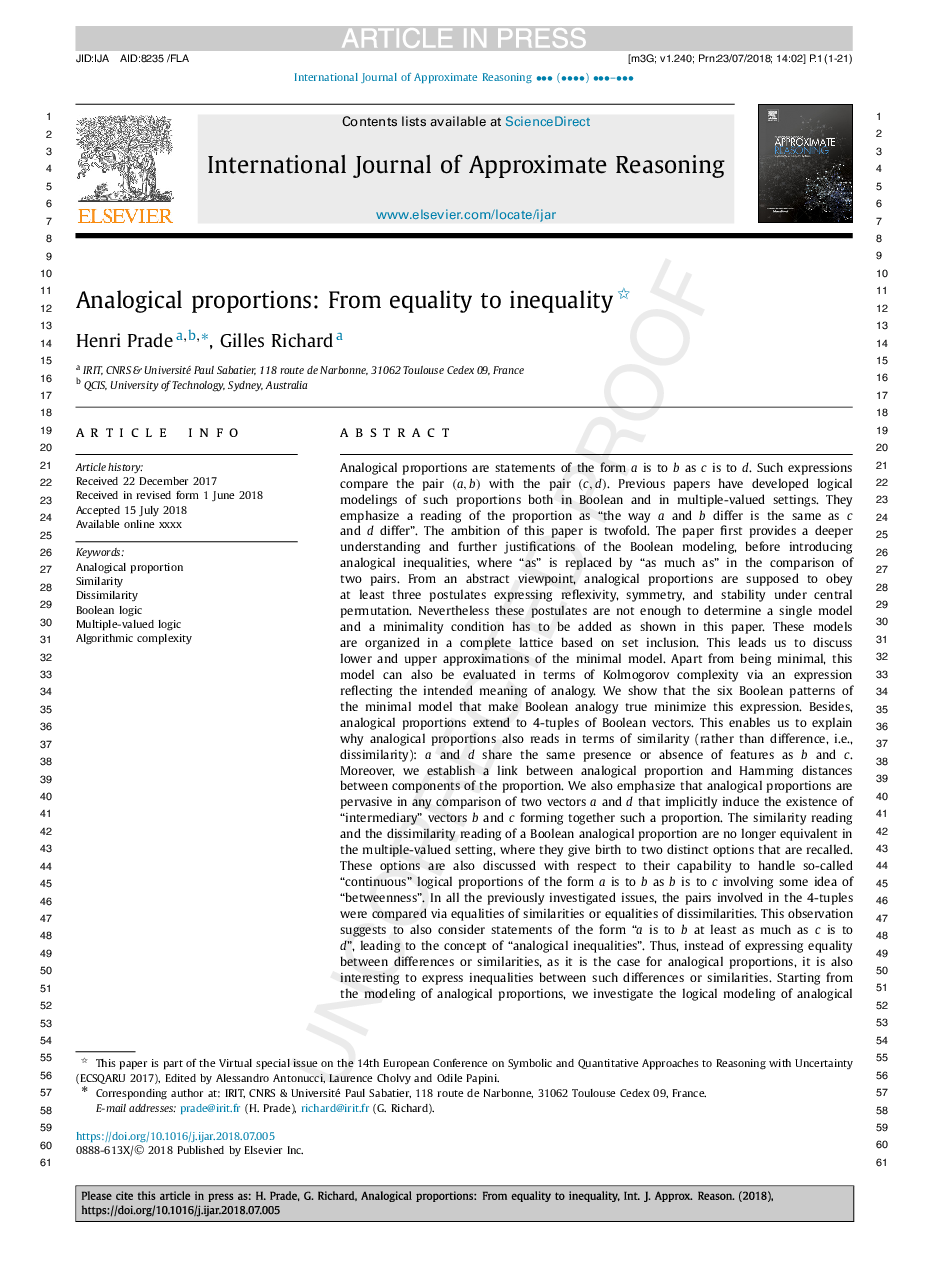| کد مقاله | کد نشریه | سال انتشار | مقاله انگلیسی | نسخه تمام متن |
|---|---|---|---|---|
| 6858749 | 1438403 | 2018 | 21 صفحه PDF | دانلود رایگان |
عنوان انگلیسی مقاله ISI
Analogical proportions: From equality to inequality
ترجمه فارسی عنوان
نسبت های مشابه: از برابری به نابرابری
دانلود مقاله + سفارش ترجمه
دانلود مقاله ISI انگلیسی
رایگان برای ایرانیان
کلمات کلیدی
نسبت آنالوگ، شباهت، تناقض، منطق بولی، منطق چندگانه، پیچیدگی الگوریتمی،
موضوعات مرتبط
مهندسی و علوم پایه
مهندسی کامپیوتر
هوش مصنوعی
چکیده انگلیسی
Analogical proportions are statements of the form a is to b as c is to d. Such expressions compare the pair (a,b) with the pair (c,d). Previous papers have developed logical modelings of such proportions both in Boolean and in multiple-valued settings. They emphasize a reading of the proportion as “the way a and b differ is the same as c and d differ”. The ambition of this paper is twofold. The paper first provides a deeper understanding and further justifications of the Boolean modeling, before introducing analogical inequalities, where “as” is replaced by “as much as” in the comparison of two pairs. From an abstract viewpoint, analogical proportions are supposed to obey at least three postulates expressing reflexivity, symmetry, and stability under central permutation. Nevertheless these postulates are not enough to determine a single model and a minimality condition has to be added as shown in this paper. These models are organized in a complete lattice based on set inclusion. This leads us to discuss lower and upper approximations of the minimal model. Apart from being minimal, this model can also be evaluated in terms of Kolmogorov complexity via an expression reflecting the intended meaning of analogy. We show that the six Boolean patterns of the minimal model that make Boolean analogy true minimize this expression. Besides, analogical proportions extend to 4-tuples of Boolean vectors. This enables us to explain why analogical proportions also reads in terms of similarity (rather than difference, i.e., dissimilarity): a and d share the same presence or absence of features as b and c. Moreover, we establish a link between analogical proportion and Hamming distances between components of the proportion. We also emphasize that analogical proportions are pervasive in any comparison of two vectors a and d that implicitly induce the existence of “intermediary” vectors b and c forming together such a proportion. The similarity reading and the dissimilarity reading of a Boolean analogical proportion are no longer equivalent in the multiple-valued setting, where they give birth to two distinct options that are recalled. These options are also discussed with respect to their capability to handle so-called “continuous” logical proportions of the form a is to b as b is to c involving some idea of “betweenness”. In all the previously investigated issues, the pairs involved in the 4-tuples were compared via equalities of similarities or equalities of dissimilarities. This observation suggests to also consider statements of the form “a is to b at least as much as c is to d”, leading to the concept of “analogical inequalities”. Thus, instead of expressing equality between differences or similarities, as it is the case for analogical proportions, it is also interesting to express inequalities between such differences or similarities. Starting from the modeling of analogical proportions, we investigate the logical modeling of analogical inequalities, both in the Boolean and in the multiple-valued cases, and discuss their potential use in relation with some recent related work in computer vision.
ناشر
Database: Elsevier - ScienceDirect (ساینس دایرکت)
Journal: International Journal of Approximate Reasoning - Volume 101, October 2018, Pages 234-254
Journal: International Journal of Approximate Reasoning - Volume 101, October 2018, Pages 234-254
نویسندگان
Henri Prade, Gilles Richard,
